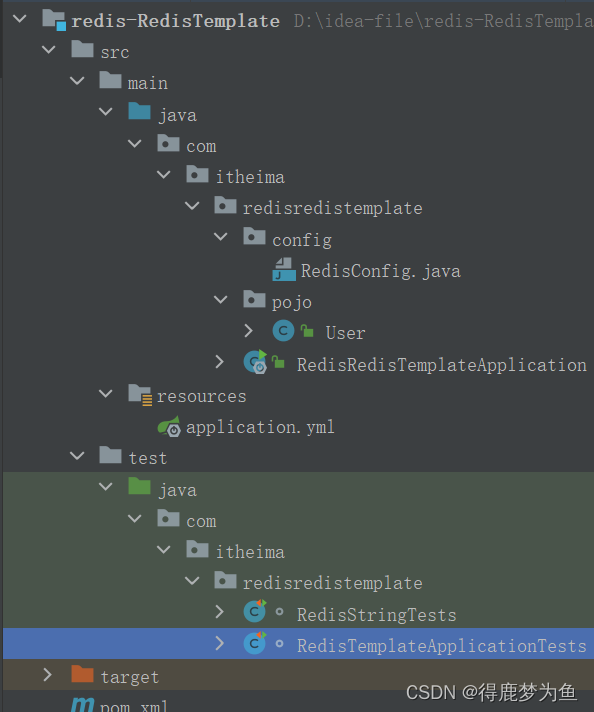项目创建步骤:
1.引入依赖
<!-- Redis依赖 -->
<dependency>
<groupId>org.springframework.boot</groupId>
<artifactId>spring-boot-starter-data-redis</artifactId>
</dependency>
<!-- 连接池依赖-->
<dependency>
<groupId>org.apache.commons</groupId>
<artifactId>commons-pool2</artifactId>
</dependency>
<!-- json依赖-->
<dependency>
<groupId>com.fasterxml.jackson.core</groupId>
<artifactId>jackson-databind</artifactId>
<version>2.14.1</version>
</dependency>2.配置application.yml/yaml/properties文件
spring:
redis:
host: 192.168.22.128
port: 6379
# password: 123456 #有设置了密码就填,没有就不用写
lettuce:
pool:
max-active: 8 #最大连接数
max-idle: 8 #最大空闲连接数
min-idle: 0 #最小空闲连接数
max-wait: 100 #连接等待时间
3.注入RedisTemplate
@Autowied
private RedisTemplate redisTemplate;4.编写测试
@Test
void testString() {
// 插入一条String类型的数据
redisTemplate.opsForValue().set("name","Jack");
//获取该数据
Object name = redisTemplate.opsForValue().get("name");
System.out.println(name);
}完整的项目:
项目截图:

1.pom.xml文件:
<dependencies>
<!-- Redis依赖 -->
<dependency>
<groupId>org.springframework.boot</groupId>
<artifactId>spring-boot-starter-data-redis</artifactId>
</dependency>
<!-- 连接池依赖-->
<dependency>
<groupId>org.apache.commons</groupId>
<artifactId>commons-pool2</artifactId>
</dependency>
<!-- json依赖-->
<dependency>
<groupId>com.fasterxml.jackson.core</groupId>
<artifactId>jackson-databind</artifactId>
<version>2.14.1</version>
</dependency>
<dependency>
<groupId>org.projectlombok</groupId>
<artifactId>lombok</artifactId>
<optional>true</optional>
</dependency>
<dependency>
<groupId>org.springframework.boot</groupId>
<artifactId>spring-boot-starter-test</artifactId>
<scope>test</scope>
</dependency>
</dependencies>2.User实体类:
package com.itheima.redisredistemplate.pojo;
import lombok.AllArgsConstructor;
import lombok.Data;
import lombok.NoArgsConstructor;
/**
* @author :LTY
* @date :Created in 2023/6/24 23:41
* @description:实体类
* @modified By:
* @version: $
*/
@Data
@AllArgsConstructor
@NoArgsConstructor
public class User {
private String name;
private Integer age;
}
3.RedisRedisTemplateApplication主类:
package com.itheima.redisredistemplate;
import org.springframework.boot.SpringApplication;
import org.springframework.boot.autoconfigure.SpringBootApplication;
@SpringBootApplication
public class RedisRedisTemplateApplication {
public static void main(String[] args) {
SpringApplication.run(RedisRedisTemplateApplication.class, args);
}
}
4.RedisTemplateApplicationTests测试类:
package com.itheima.redisredistemplate;
import com.itheima.redisredistemplate.pojo.User;
import org.junit.jupiter.api.Test;
import org.springframework.beans.factory.annotation.Autowired;
import org.springframework.boot.test.context.SpringBootTest;
import org.springframework.data.redis.core.RedisTemplate;
@SpringBootTest
class RedisTemplateApplicationTests {
@Autowired
private RedisTemplate redisTemplate;
@Test
void testString() {
// 插入一条String类型的数据
redisTemplate.opsForValue().set("name","Jack2");
//获取该数据
Object name = redisTemplate.opsForValue().get("name");
System.out.println(name);
}
@Test
void testSaveUser() {
//写入对象数据
redisTemplate.opsForValue().set("user:4",new User("胡歌",34));
//获取数据
User user = (User) redisTemplate.opsForValue().get("user:4");
System.out.println(user);
}
}
5.application.yml配置文件:
spring:
redis:
host: 192.168.22.128 #这里需要改为你的虚拟机的ip地址
port: 6379 #6379为默认端口
# password: 123456 #redis没有设置密码,则不需要填写
lettuce:
pool:
max-active: 8 #最大连接数
max-idle: 8 #最大空闲数
min-idle: 0 #最小空闲数
max-wait: 100ms #最大等待时间
运行项目后,虽然成功运行了,但是在存入RDM内的数据为:

这是由于RedisTemplate没有对数据进行序列化。
RedisTeplate的两种序列化实践方法:
①方法一:
1.自定义RedisTemplate
2.修改RedisTemplate的序列化器为GenericJackson2JsonRedisSerializer
- 创建一个RedisConfig类用于RedisTemplate序列化:
package com.itheima.redisredistemplate.config;
import org.springframework.context.annotation.Bean;
import org.springframework.context.annotation.Configuration;
import org.springframework.data.redis.connection.RedisConnectionFactory;
import org.springframework.data.redis.core.RedisTemplate;
import org.springframework.data.redis.serializer.GenericJackson2JsonRedisSerializer;
import org.springframework.data.redis.serializer.RedisSerializer;
/**
* @author :LTY
* @date :Created in 2023/6/24 23:23
* @description:RedisTemplate序列化
* @modified By:
* @version: $
* 要注入connectionFactory须在该类上添加注释@Configuration
*/
@Configuration //表示此类为配置类
public class RedisConfig {
@Bean
public RedisTemplate<String,Object> redisTemplate(RedisConnectionFactory connectionFactory) {
//1.创建RedisTemplate对象
RedisTemplate<String, Object> template = new RedisTemplate<>();
//2.设置连接工厂
template.setConnectionFactory(connectionFactory);
//3.创建JSON序列化工具
GenericJackson2JsonRedisSerializer jsonRedisSerializer = new GenericJackson2JsonRedisSerializer();
//4.设置Key的序列化
template.setKeySerializer(RedisSerializer.string());
template.setHashKeySerializer(RedisSerializer.string());
//5.设置Value的序列化
template.setValueSerializer(jsonRedisSerializer);
template.setHashValueSerializer(jsonRedisSerializer);
return template;
}
}
- 修改RedisTemplateApplicationTests测试类的代码:
@Autowired
private RedisTemplate redisTemplate;改为:
@Autowired
private RedisTemplate<String,Object> redisTemplate;在RDM显示的结果为:

由于每次添加一条数据,都会生成一个@class,占用内存,故推荐使用第二种方法进行序列化。
②方法二:
1.使用StringRedisTemplate
2.写入Rediss时,手动把对象序列化为JSON
3.读取Redis时,手动把读取到的JSON反序列化为对象
- 为了方便对比两种方法达到的效果,新建一个RedisStringTests测试类:
package com.itheima.redisredistemplate;
import com.fasterxml.jackson.core.JsonProcessingException;
import com.fasterxml.jackson.databind.ObjectMapper;
import com.itheima.redisredistemplate.pojo.User;
import org.junit.jupiter.api.Test;
import org.springframework.beans.factory.annotation.Autowired;
import org.springframework.boot.test.context.SpringBootTest;
import org.springframework.data.redis.core.RedisTemplate;
import org.springframework.data.redis.core.StringRedisTemplate;
import java.util.Map;
@SpringBootTest
class RedisStringTests {
@Autowired
private StringRedisTemplate stringRedisTemplate;
@Test
void testString() {
// 插入一条String类型的数据
stringRedisTemplate.opsForValue().set("name","Jack");
//获取该数据
Object name = stringRedisTemplate.opsForValue().get("name");
System.out.println(name);
}
private static final ObjectMapper mapper = new ObjectMapper();
@Test
void testSaveUser() throws JsonProcessingException {
//创建User对象
User user = new User("胡歌",34);
//手动序列化
String json = mapper.writeValueAsString(user);
//写入对象数据
stringRedisTemplate.opsForValue().set("user:5",json);
//获取数据
String json2 = stringRedisTemplate.opsForValue().get("user:5");
//手动序列化
User user1 = mapper.readValue(json2, User.class);
System.out.println(user1);
}
// Hash
@Test
void testHash() {
// 插入hash数据
stringRedisTemplate.opsForHash().put("user:6","name","彭于晏");
stringRedisTemplate.opsForHash().put("user:6","age","32");
//获取hash数据
Map<Object, Object> entries = stringRedisTemplate.opsForHash().entries("user:6");
System.out.println("entries = " + entries);
}
}
在RDM显示的结果为:






















 2341
2341











 被折叠的 条评论
为什么被折叠?
被折叠的 条评论
为什么被折叠?








